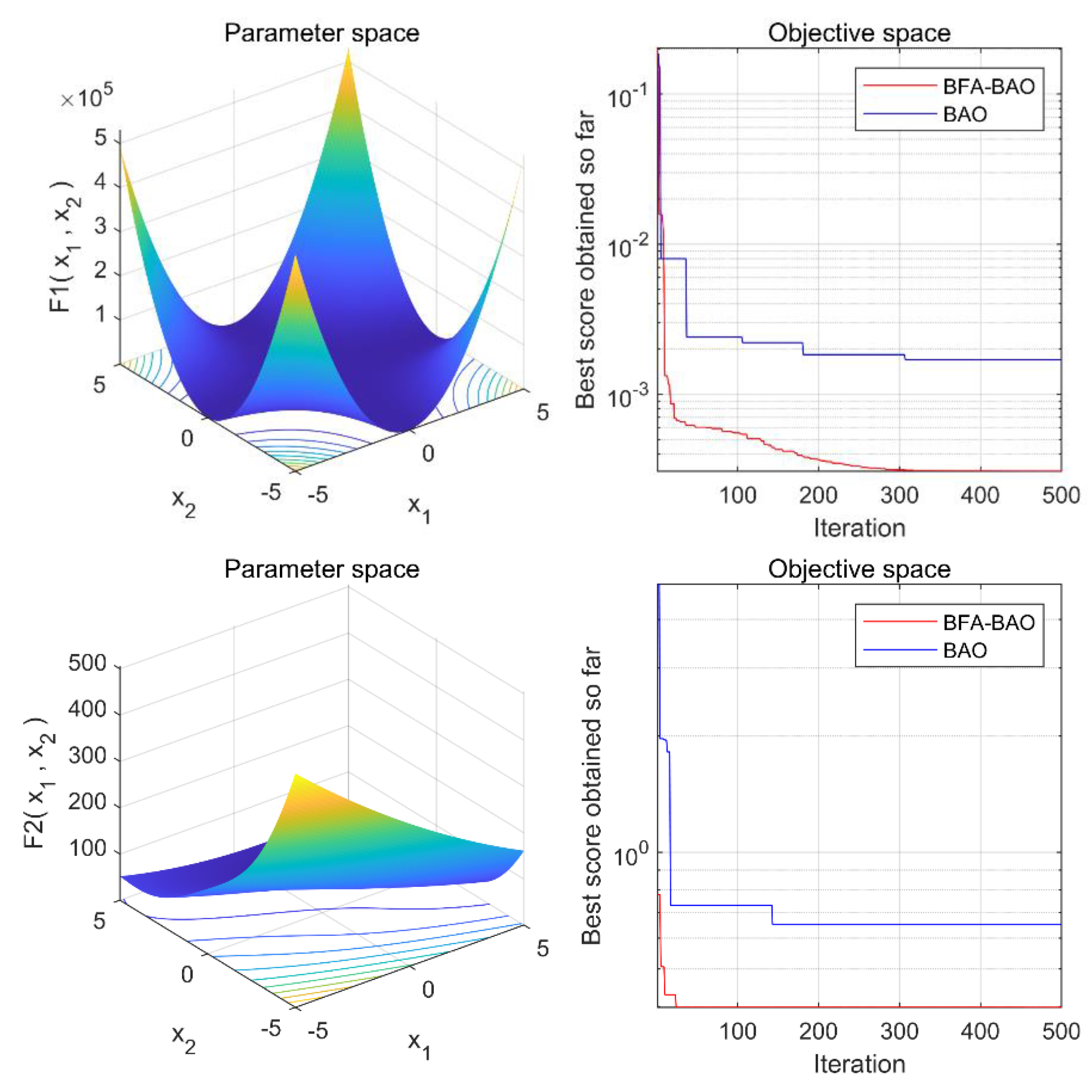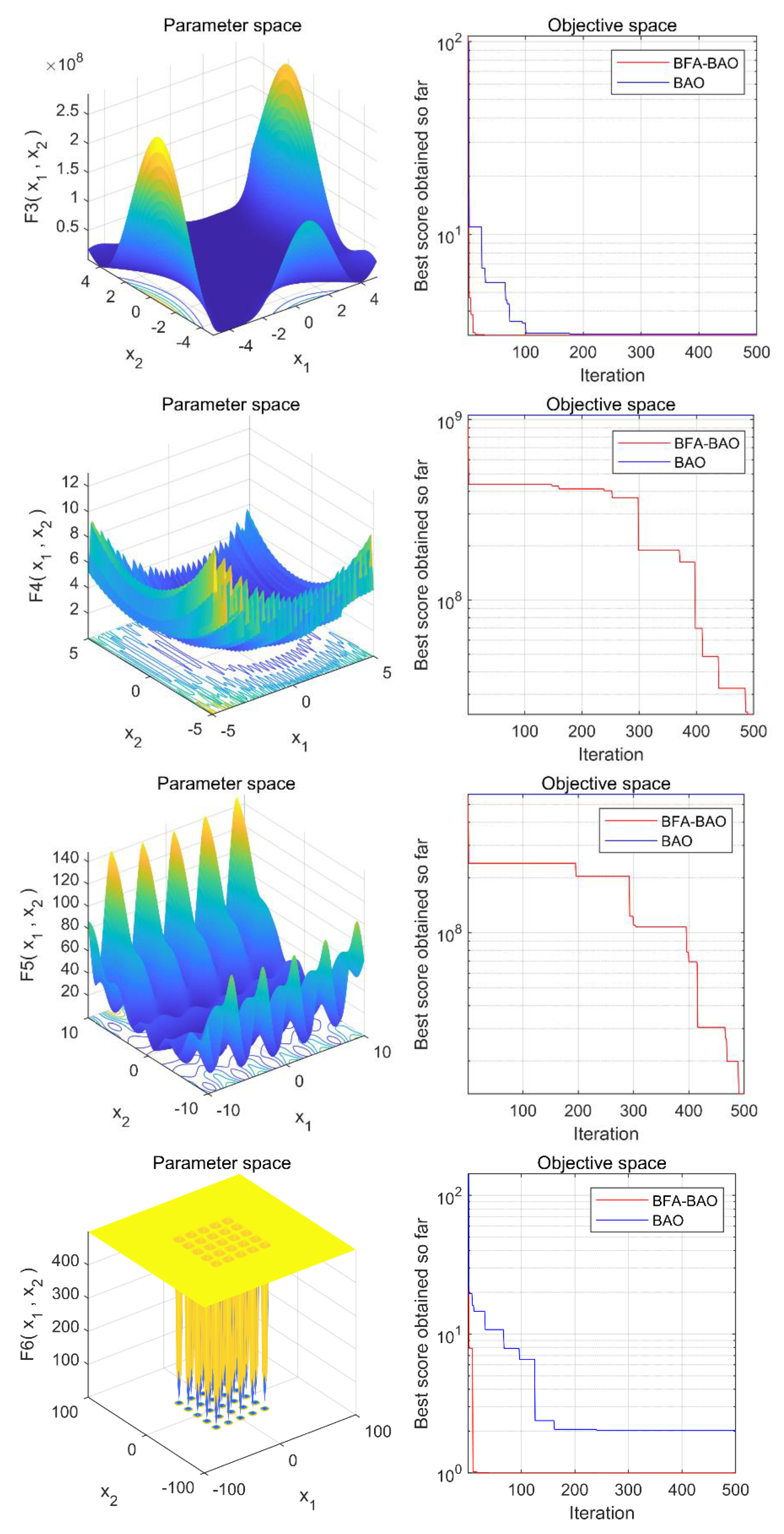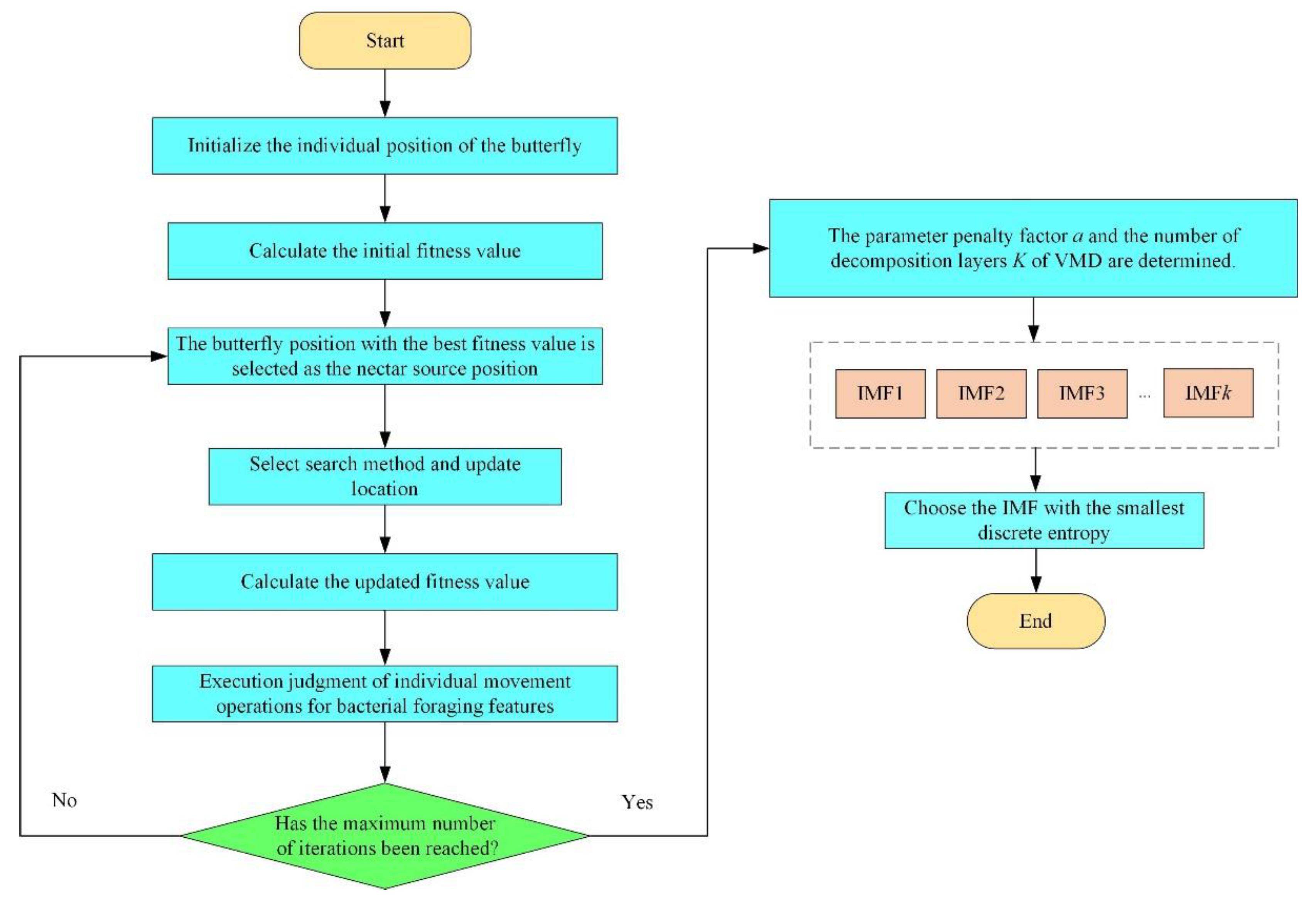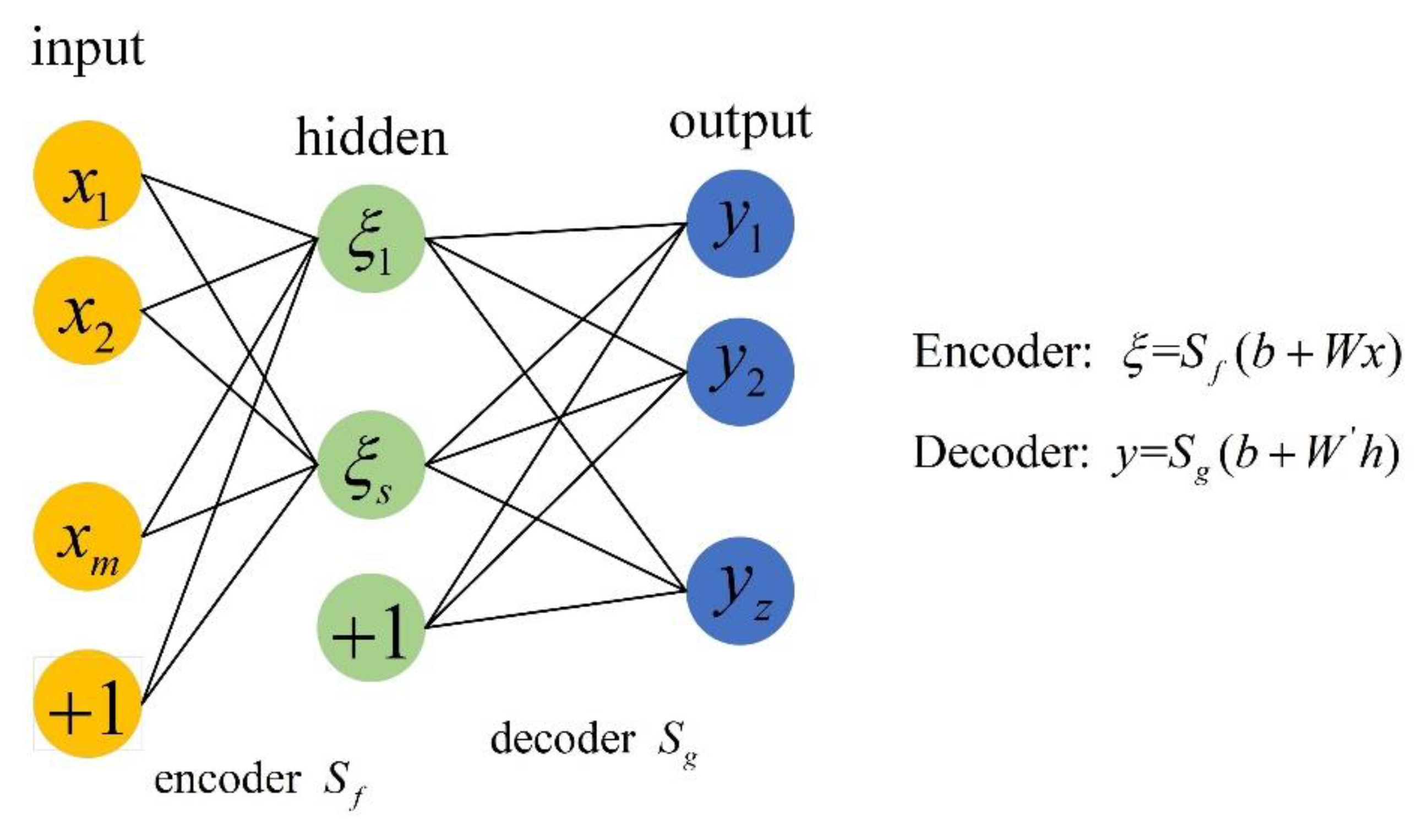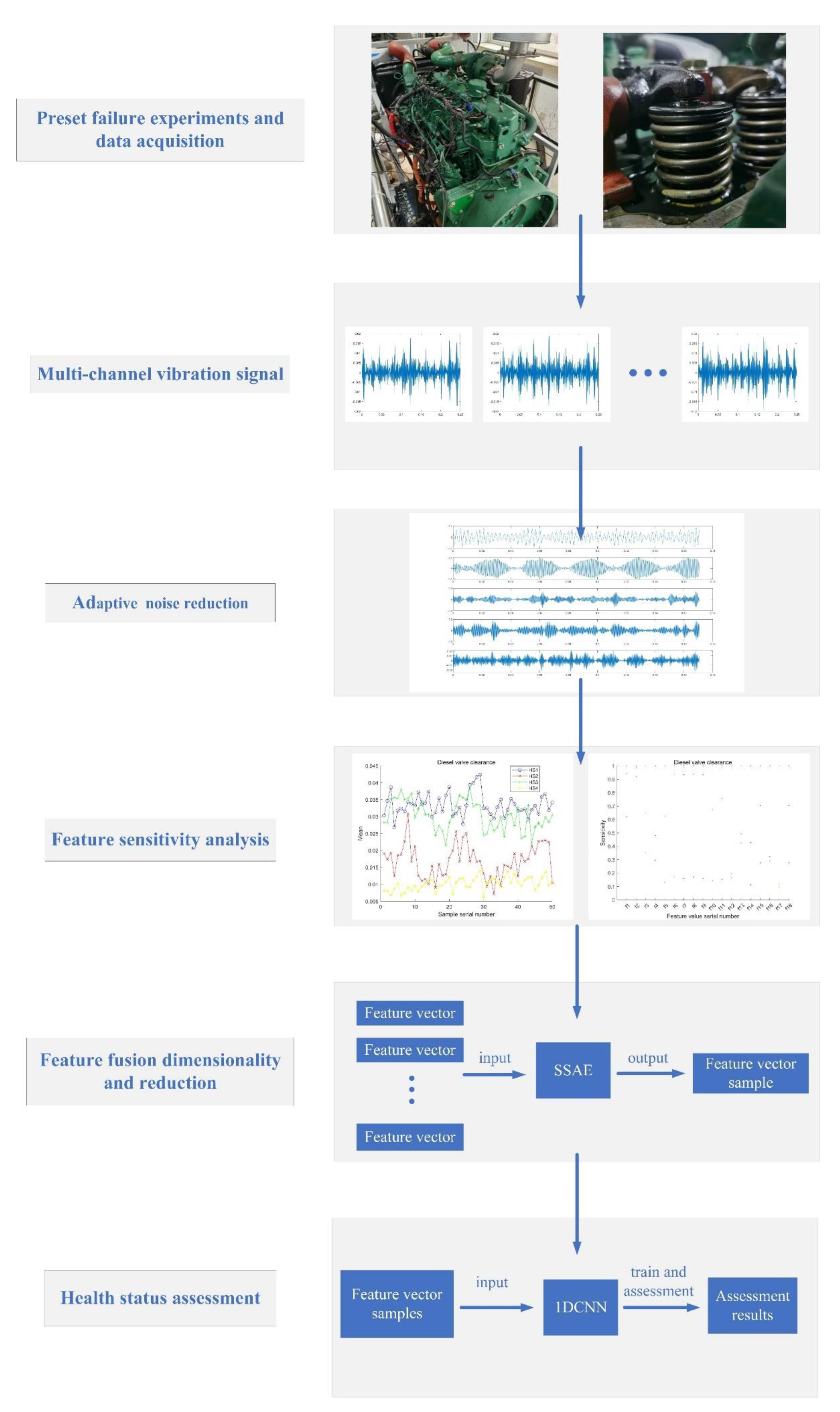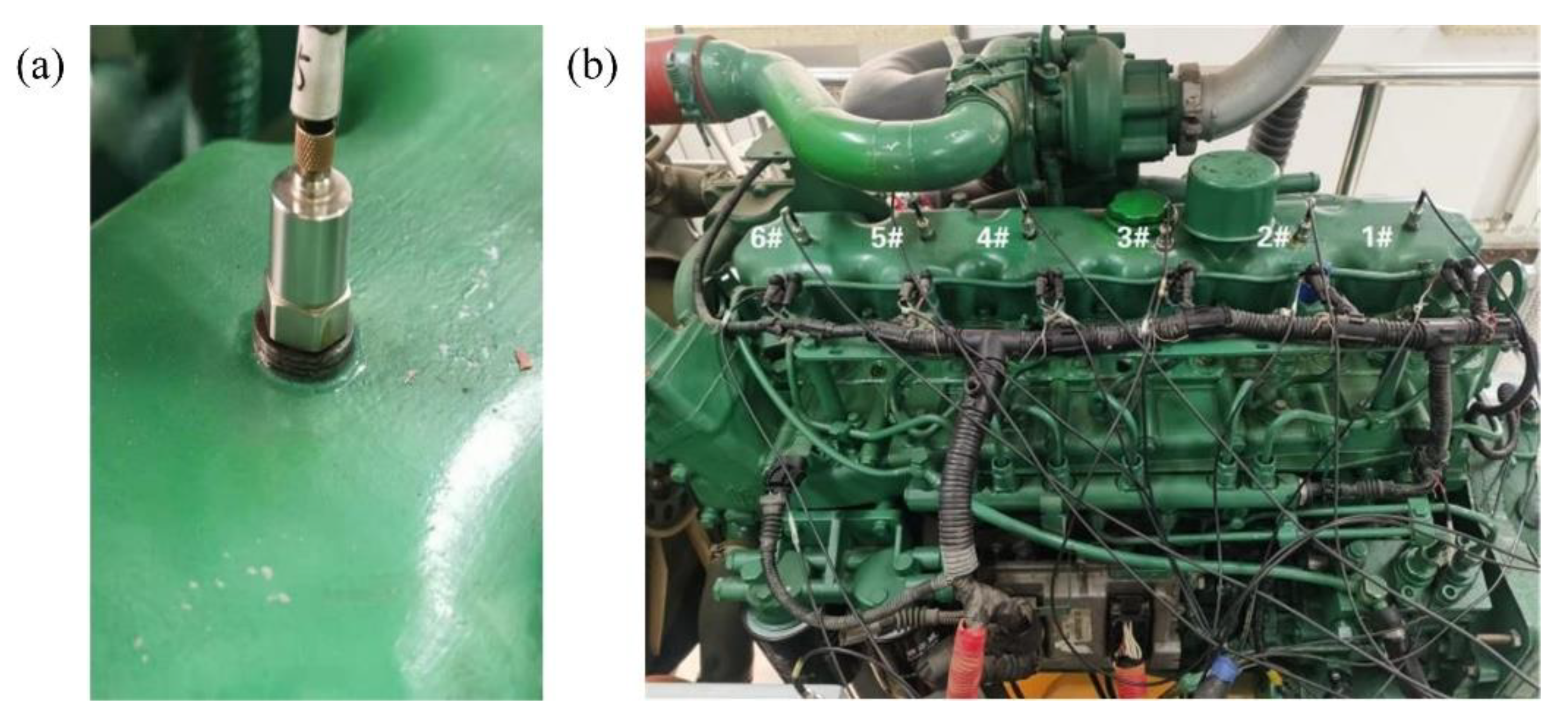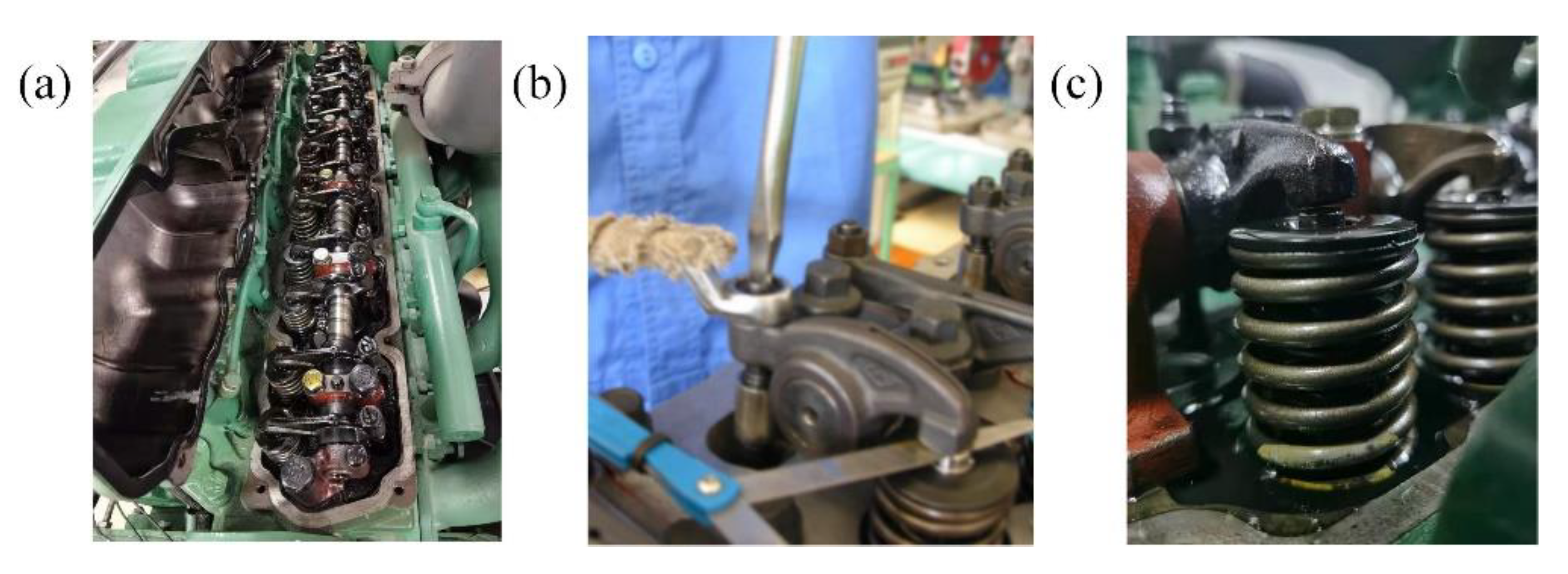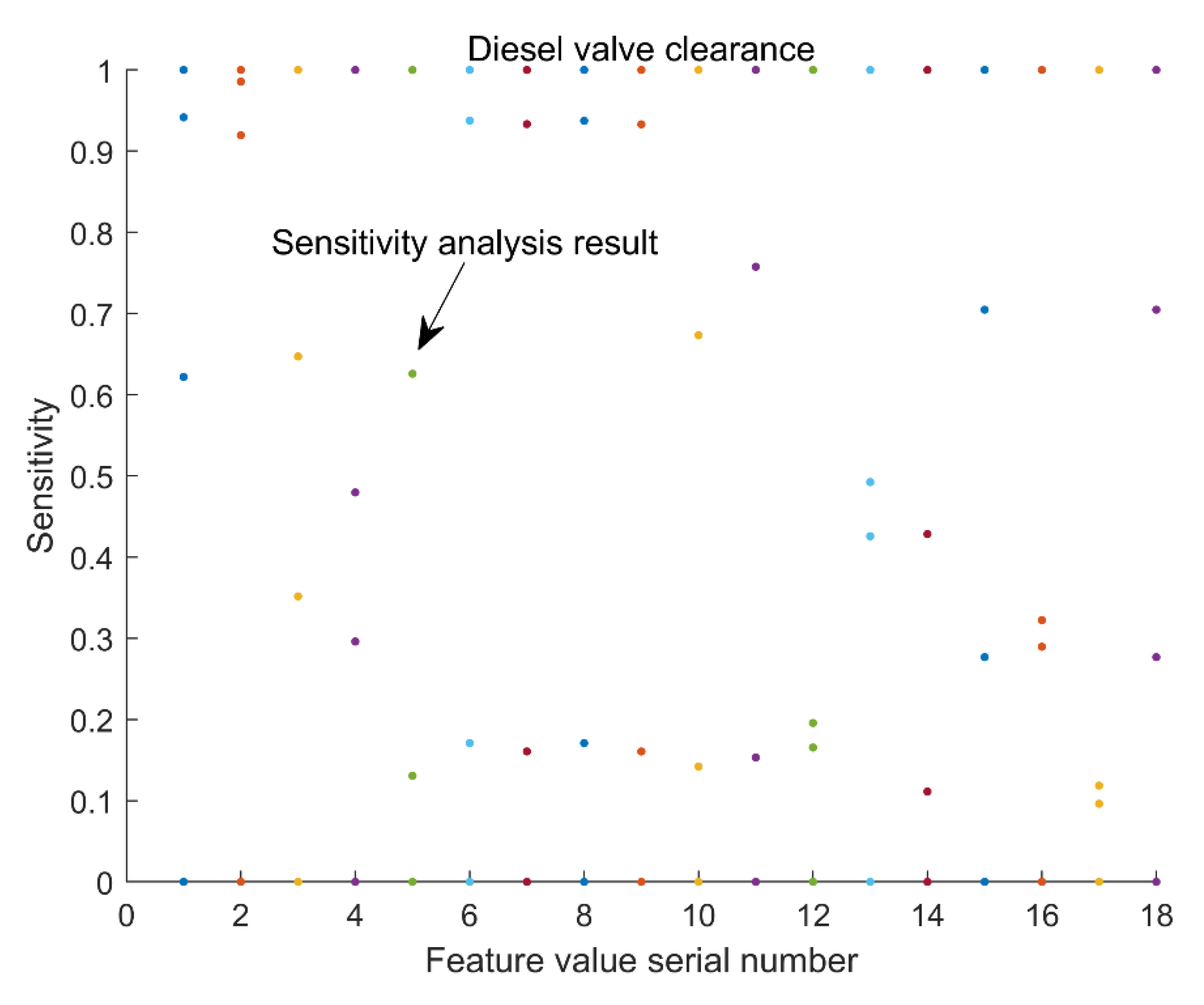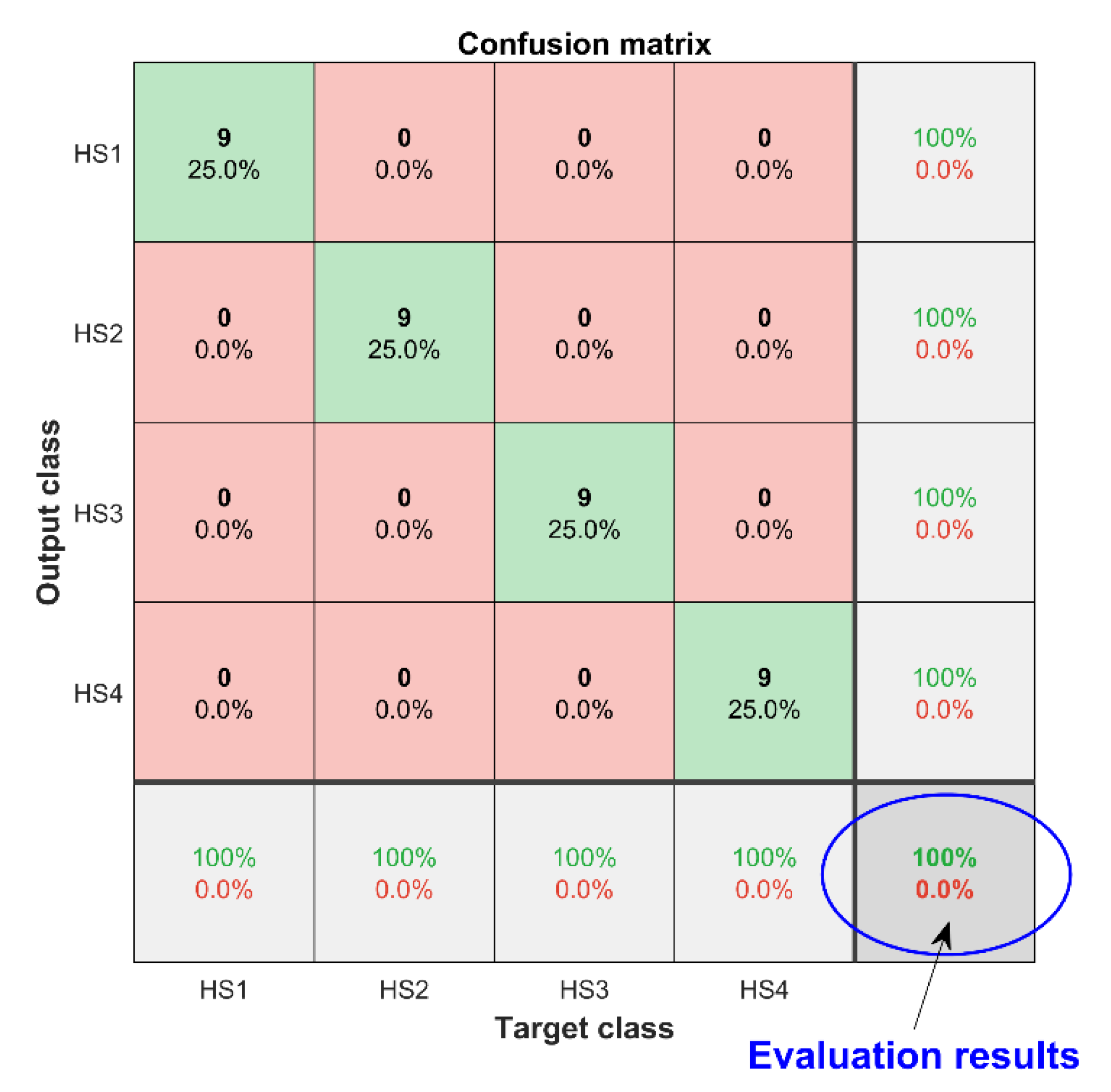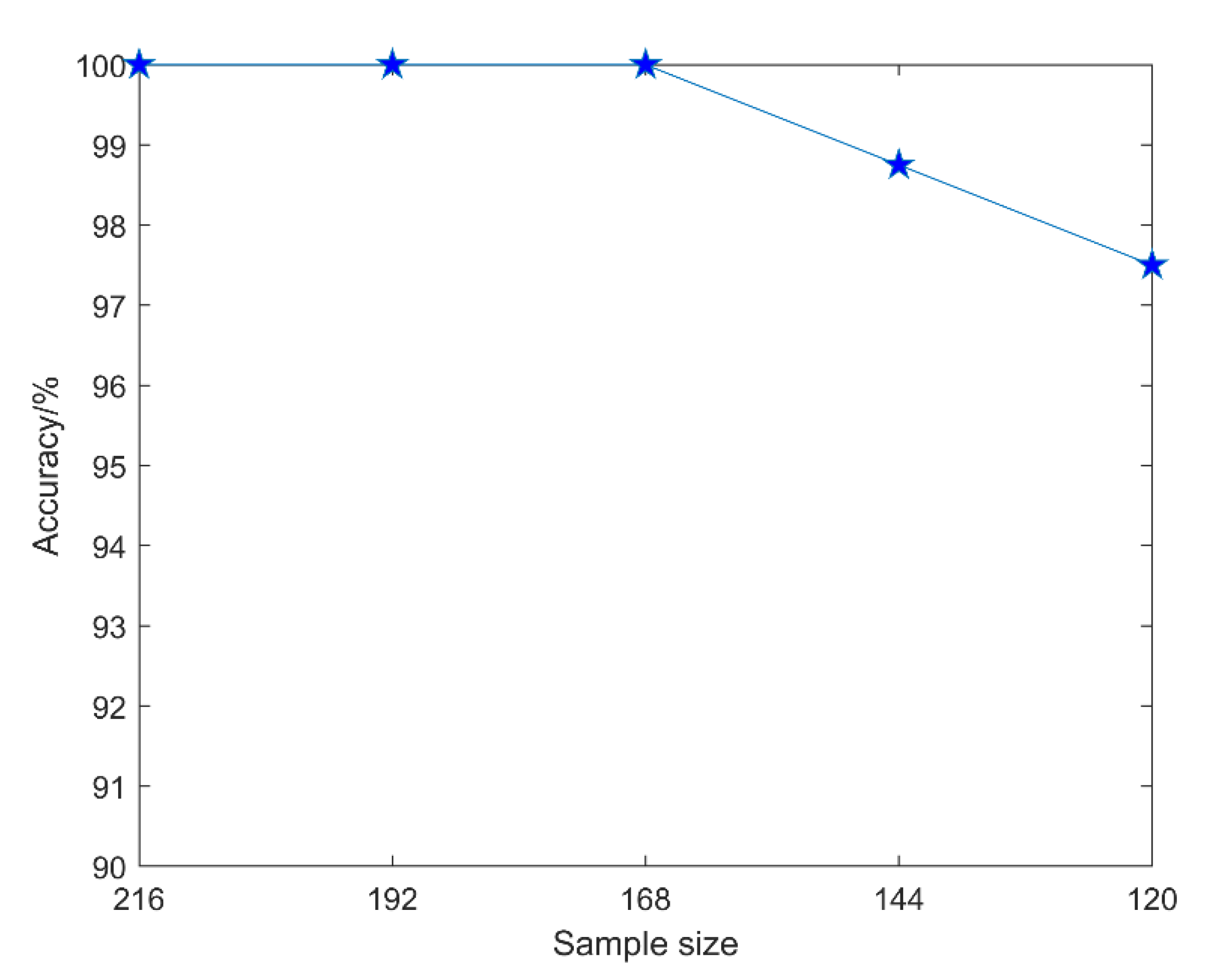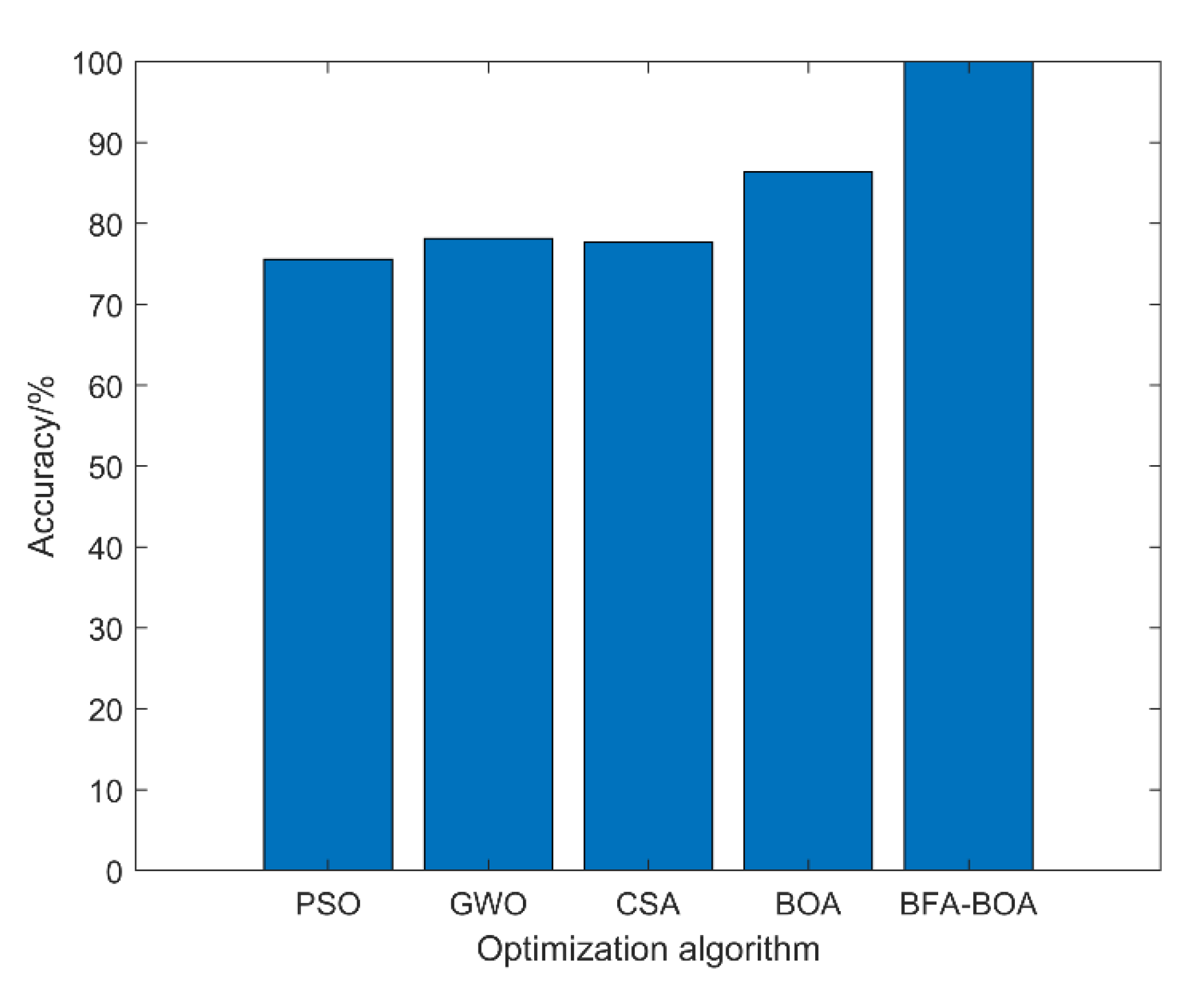1. Introduction
As the main power core of large mechanical equipment, the diesel engine is widely used in transportation, industrial production, agricultural machinery, the chemical industry, national defense and military equipment, and other fields [
1,
2,
3]. Whether the diesel engine can work normally and healthily often directly affects the normal operation of the entire equipment system. Therefore, it is of great significance to carry out effective condition monitoring and health assessment for diesel engines. In engineering practice, with the prolongation of service time, the valve spring of a diesel engine may gradually deteriorate and deform, and the valve will wear and deposit carbon, which will lead to an abnormal increase of valve clearance, will reduce the efficiency of cylinder flow control, and will then cause the power of diesel engine to decrease. At the same time, the continuous abnormal increase of valve clearance may also cause vicious failures such as cylinder impact or valve breakage, causing huge economic losses and even threatening personal safety [
4,
5]. In the actual state monitoring process, it is very difficult to directly measure the valve clearance of the diesel engine, and the timeliness is low. The vibration signal of the cylinder head of the diesel engine contains rich state information brought by the inertial impact in the working cycle and various random excitations [
6,
7]. Therefore, in this study, the vibration signal of the diesel engine cylinder head was collected and its health status was monitored. The process of diesel engine health status assessment mainly includes signal monitoring, data preprocessing, feature extraction, and health status recognition.
The first is the aspect of signal monitoring; most of the current monitoring of vibration signals of diesel engine cylinder heads usually only have a single sensor dimension. A large number of studies have shown that, in the state monitoring and state identification of equipment, multi-dimensional signal monitoring can often achieve better evaluation results than single-dimensional monitoring. Pan et al. [
8] conducted an effective evaluation of the performance degradation process of wind turbine gearboxes based on multi-sensor fusion data. Dong et al. [
9] achieved a high-precision health status diagnosis and a prediction of hydraulic pump equipment based on a hidden semi-Markov model by collecting multi-sensor signals of the hydraulic pump. Kamal Jafarian et al. [
10] used vibration data captured by four sensors placed at different positions on the car engine and in different experimental environments to investigate engine failures, including misfire and valve clearance failures, and combined time-frequency domain analysis methods and neural networks to realize the engine failure mode diagnosis. In this regard, this paper built a multi-sensor monitoring system, conducted a simulated degradation experiment of diesel valve clearance, and collected multi-dimensional cylinder head vibration signals, covering the health status information of the diesel engine from multiple dimensions.
Further, due to the complex structure of the diesel engine, the vibration signal of the cylinder head incorporates the vibration excitation of the whole engine, showing strong non-stationarity and nonlinearity. Therefore, the effective processing and analysis of the vibration signal of the diesel engine cylinder head are also one of the difficulties in its state evaluation process. In this regard, scholars have carried out effective and feasible research. Wei et al. [
11] used time synchronization and least squares polynomial fitting to preprocess the original signal and obtained the diesel engine combustion noise transfer function according to the motor test and different injection strategies. Xi et al. [
12] used the Stockwell transform to construct a time-frequency reference signal to guide the separation process of kernel-independent component analysis (ICA) to avoid artificial uncertainties in ICA. Shao et al. [
13] combined the advantages of the manifold learning algorithm to process nonlinear data and carried out diversified preprocessing on the vibration signal of a marine diesel engine, which greatly improved the quality of feature extraction. Although the above research has achieved certain results, it cannot effectively self-adaptively separate and de-noise the status information and noise interference components in the diesel engine cylinder head signal. In this regard, Wang et al. [
14] used a new adaptive wavelet packet threshold function for vibration signal denoising, which can extract truly physically meaningful components from the signal. Wang et al. [
15] combined power spectral entropy and variational mode decomposition (VMD) to adaptively process the vibration signal of the diesel engine and used Rihaczek distribution to obtain the time-frequency representation of the diesel engine with high aggregation. Liu et al. [
16] proposed an adaptive Wigner-Ville distribution (WVD) and an improved fast correlation filter (FCBF) to solve the cross-term interference of WVD and the redundant control problem of fast FCBF, which effectively separated the vibration signal of the diesel engine’s redundant interference information. Inspired by the above research, we first used the bacterial foraging algorithm (BFA) to improve the optimization performance of the butterfly optimization algorithm (BOA); then, the key parameters
and
in the VMD were optimized based on discrete entropy to realize the adaptive noise reduction of the vibration signal of the diesel engine cylinder head.
In the aspect of signal feature extraction, the time-frequency characteristic analysis of the signal can show the effective state components in the equipment signal from the perspective of the excitation coupling mechanism. Tao et al. [
17] used the time-domain statistical method to extract the time-domain features of the signal and obtained high-precision time-frequency domain features through high-resolution multi-synchronous compression transformation. Ahmad Taghizadeh-Alisaraei et al. [
18] used time-frequency analysis methods such as short-term Fourier transform (STFT), Wigner-Ville distribution (WVD), and Choi-Williams distribution (CWD) to examine in detail the vibrations produced by a faulty engine. By comparing the time-frequency domain parameters of the vibration response of the normal and faulty injectors, the faulty injectors are effectively detected. Qin et al. [
19] combined the extracted time-domain, time-frequency domain, and hand-crafted time-domain statistical features and fed them into a multi-channel deep Siamese convolutional neural network to resist the influence of environmental noise and operating condition changes on the final diagnosis results. Although the above research methods can effectively realize the feature extraction of diesel engine cylinder head vibration signals, the selection of feature parameters is mostly artificial, which brings greater uncertainty to the accuracy of a diesel engine health status assessment. Therefore, we conducted a characteristic sensitivity analysis on the vibration signal of the cylinder head of the diesel engine and selected the characteristic parameters sensitive to the state of health of the diesel engine valve to improve the accuracy of the evaluation.
On the other hand, the multi-channel sensor signal features have redundant information; thus, the effective dimensionality reduction of the features can improve the accuracy of the state evaluation and reduce a certain amount of calculation. In this regard, Yang et al. [
20] introduced class information into the traditional non-negative matrix factorization (NMF) and developed an improved discriminative NMF method to achieve the effective dimensionality reduction of time-frequency images of diesel engine vibration signals. Hou et al. [
21] used principal component analysis (PCA) to convert high-dimensional fault samples into low-dimensional samples to reduce the computational complexity for the problem of the high dimensionality of fault samples collected by multi-sensors. Chu et al. [
22] proposed a visualization method based on texture-enhanced block non-negative matrix factorization (TE-BNMF). By performing time-frequency analysis on the vibration signal of the diesel engine cylinder head and then using the block non-negative matrix factorization (BNMF) algorithm to directly reduce the dimension to extract the feature parameters of the generated local binary feature map, the dimension reduction and enhancement of the feature map were realized. Although the above information fusion method plays the role of feature dimensionality reduction, it still cannot achieve the effect of deep fusion dimensionality reduction and effective state feature enhancement for effective information in multi-dimensional feature samples; therefore, the sparse autoencoder (SAE) with a strong data feature dimensionality reduction and representation ability was selected to perform deep dimensionality reduction learning on multidimensional feature data. SAE adds sparse constraints to the mapping process of the original autoencoder, has stronger data reconstruction and learning capabilities, and is widely used in various fields of military and industry (pattern recognition, semantic segmentation, image processing, etc.) [
23,
24,
25]. Further, we stacked two SAEs together to form a stacked SAE (SSAE), which achieves a better feature dimensionality reduction and feature enhancement by increasing the parameter space and mapping calculation. Finally, in terms of health status recognition, since the feature samples after feature fusion are one-dimensional, we built a one-dimensional convolutional network (1DCNN) to achieve effective mapping between diesel engine feature samples and health status. A large number of studies have proven that, compared to traditional machine learning methods, deep networks have stronger data mining and analysis and learning capabilities [
26,
27]. Therefore, the evaluation method using 1DCNN as the identification model can accurately and effectively realize the health status evaluation of diesel engine valves.
To sum up, this paper proposes a health status assessment of diesel engine valve clearance based on BFA-BOA-VMD adaptive noise reduction and multi-channel information fusion; then, the effectiveness of the proposed diesel engine state of health assessment method is proven by the diesel engine valve clearance preset simulation experiment. The main contributions and innovations of this paper are as follows:
(1) We carried out a multi-dimensional sensor monitoring system, the valve clearance degradation preset simulation experiment of the diesel engine, and the acquisition of the multi-dimensional vibration signal of the diesel engine cylinder head was realized.
(2) The optimization algorithm and the discrete entropy were combined to realize the adaptive noise reduction of the vibration signal of the diesel engine cylinder head, and then, through feature sensitivity analysis, effective sensitive feature parameters were selected.
(3) We used SSAE with the stacked structure to realize the deep dimensionality reduction and feature reconstruction of multi-dimensional feature samples. Finally, the effective state evaluation of the diesel engine valve clearance was realized through the constructed 1DCNN.
The rest of this paper is organized as follows:
Section 2 details the relevant theory and evaluation process of health status assessment methods;
Section 3 provides the implementation of the diesel valve clearance degradation preset failure experiment and the preparation of the data samples;
Section 4 analyzes and discusses the results of the diesel engine clearance condition assessment; finally,
Section 5 presents the conclusions of this study and an outlook for future work.
6. Conclusions
The valve train is one of the key components of a diesel engine. If the valve clearance of the diesel engine continues to increase abnormally, it may cause serious failures such as cylinder collision or valve breakage, and it will also threaten the safety of operators. Based on this situation, this paper proposed a health status assessment of diesel engine valve clearance based on BFA-BOA-VMD adaptive noise reduction and multi-channel information fusion, which effectively improved the accuracy of the diesel engine valve gap health state assessment. By carrying out the simulation experiment of diesel engine valve clearance degradation, the vibration signal of the multi-channel diesel engine cylinder head was collected, and the BFA-BOA-VMD method was used to realize the adaptive noise reduction of the signal and the selection of effective IMF components, which improved the signal-to-noise ratio of the signal. Further, the characteristic sensitivity analysis selected the time-domain and frequency-domain characteristic parameters that are sensitive to the state of health of the diesel valve clearance. Feature fusion and dimensionality reduction based on SSAE network further reconstructed and enhanced data features, highlighting state information. Finally, we conducted health status assessment experiments on the diesel engine valve gap preset experimental data set. Experimental results showing that, compared with the common state assessment algorithm, the proposed method has good evaluation accuracy and superiority.
To sum up, the method for assessing the health status of diesel engine valve clearances proposed in this paper, as an important technical means in equipment health management, has very important application prospects and significance and also provides new theoretical support and ideas for equipment health management and assessment. In future research, more effective signal noise reduction methods, feature fusion methods with stronger reconstruction capability, and deep network models with stronger learning abilities can be further studied.
